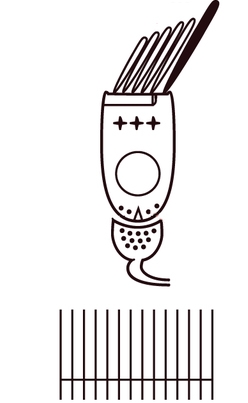Maculae (Otolithic Organs: utriculo-saccular function) are the sensory receptors for linear acceleration (ie, gravity and translational movements) in all three dimensions. The utricle and saccule are known as the otoliths because their hair cells are weighted with stone-like crystals, and it follows that the otoliths are responsible for the detection of the effects of gravity.
The utricles are distinct to the semi-circular canals (which are limited to encoding angular acclereration as velocity), since they encode both head tilt, and linear acceleration.
This means that an identical output from the utricle can be the result of two distinctly different processes (head tilt or linear acceleration), and to resolve this issue, the brain requires additional inputs from both the semicircular canals, and the cerebellum.
As with the semicircular canals, so too the otolith organs have a constant, baseline firing rate, which is steady and relatively high when standing upright. The firing rate reflected in the vestibular nerve fibres increases or decreases depending on the direction of tilt, for example1.
The utricle and saccule signal that the head is translating or changing its position relative to gravity.
- Linear acceleration includes side to side movements, forward and backwards movements, and also up-and-down movements.
- Translational motion is motion that involves the sliding of an object in one or more of the three dimensions: x, y or z. Translational movements include standing up from a seated position (ie, a vertical translation) or accelerating in a car (a horizontal translation)
There are 3 translational degrees of freedom to describe linear motion:
- Heave: mediolateral (side-to-side)
- Surge: anteroposterior ( fore and aft)
- Bob: dorsoventral (up-and-down)
Contrast with rotational degrees of freedom.

Redrawn from:The Human Memory. Vestibular System. Retrieved from https://human-memory.net/vestibular-system/
The surfaces of the utricular and saccular macules are covered by the otolithic membrane, a structure consisting of a mesh of fibers embedded in a gel with a superficial layer of calcium carbonate crystals, the otoconia.
Linear accelerations produce displacements of the otoconia (due to their high mass), much like rocks rolling down a hill or a coffee cup falling off the car dashboard when suddenly accelerating2.

Redrawn from: https://www.britannica.com/science/macula

- The utricle is sensitive to a change in horizontal movement
- The saccule gives information about vertical acceleration (such as when in a lift)
- In a person standing upright and motionless, the saccules are selectively stimulated by the acceleration caused by gravity, since the saccules lie in an earth-vertical plane.
In a person lying motionless on his or her side, the utricles are selectively stimulated by the acceleration caused by gravity. Normally, the utricles lie in the earth-horizontal plane.
The hair cells of the utricle and saccule form a two-dimensional array with the two organs oriented at right angles to each other:
- Direction of linear acceleration is spatially encoded in three dimensions
- Magnitude of the acceleration is encoded by the firing rate.

The striola is a distinctive curved zone running through the cente of the maculae, and has a curved shape in order to maximize the sensitivity of the otolithic organs to linear motion in multiple trajectories. The striola divides each macula into two parts, and the hair cells on each side of the striola are oriented so that the kinocilia are in opposite directions.
- In the utricle, the kinocilia face the striola
- In the saccule, they face towards the striola.
Due to these different orientations, displacement of the otolithic membrane has an opposite effect on the set of hair cells on each side of the striola(figure 5). Thus, some hair cells are excited and some inhibited for each linear motion force or head tilt experienced. The receptors and their afferent fibres are directionally tuned for all motions or head tilts in 3D space2. The range of orientations of hair bundles within the otolith organs enables them to transmit information about linear forces in every direction the body moves, and the combined outputs of the saccule and utricle gauge the linear forces acting on the head at any instant in three dimensions1.
Polysynaptic pathways are responsible for generating compensatory torsional eye movements during static head tilt. For example, because the specific gravity of the otoconia is greater than that of the endolymph, static head tilt toward the right shoulder causes the otoconia and the stereocilia of the underlying hair cells to bend toward the right side, and this leads to excitation of the hair cells of the striola in the right utricle. Signals from the right utricle make excitatory connections to the ipsilateral vestibular nucleus, which then makes polysynaptic excitatory connections to the contralateral trochlear nucleus (and to the ipsilateral (right) superior oblique) as well as polysynaptic inhibitory connections to the ipsilateral inferior oblique subnucleus in order to inhibit the ipsilateral (right) inferior oblique3.

Redrawn from: Baloh RW, Kerber, K. Baloh and Honrubia's Clinical Neurophysiology of the Vestibular System. Oxford University Press; 2010.

